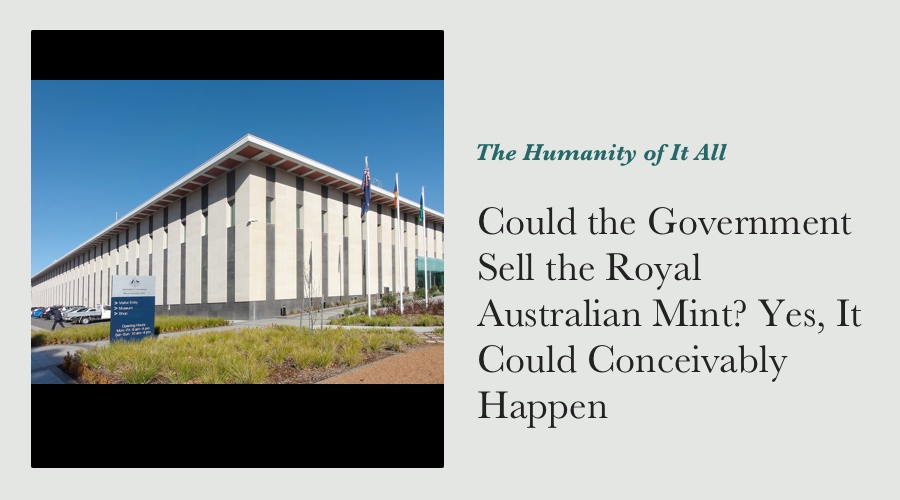Could the Government Sell the Royal Australian Mint? Yes, It Could Conceivably Happen

Conceivably yes, however most unlikely.
Each year when the announcement of Australia’s Annual Commonwealth Budget falls due, a number of stories do the rounds of mainstream media pointing towards big shakeups in expenditure and assets, as pointed to in this article in the Australian newspaper in May 2015: "Iconic assets will be sold and government departments will be slashed in a new effort to reduce the size of the public sector and raise more than $4 billion, in contentious reforms to be revealed in tomorrow’s federal budget."
One of the Commonwealth assets mentioned among those being considered for disposal was the Royal Australian Mint (RAM) - the organisation responsible for striking the coins we use each day, as well as all the coins made for Australia’s collector market.
Although the possibility of the sale of a number of national assets such as the Australian Rail Track Corporation and the registry service of the Australian Securities & Investments Commission are or were being considered, the sale of the Royal Australian Mint was ruled out pretty quickly.
This was seen to be a fairly obvious red herring - the Mint surely has too much responsibility for it to be sold to private interests, with so much of our nation’s economic integrity depending on the RAM’s products, it was thought the idea was purely academic. Some market commentators participated in the very Australian activity of “taking the piss” out of the very notion that the Mint might be sold:
"One of the greatest ideas that's been floated is that of selling the Royal Australian Mint. It's one of those plans that seems insane until you think about it a bit, and then still seems insane, but eventually if you close your eyes and sit in a quiet room for long enough, begins to make a brilliant kind of sense.
After all, why shouldn't the people making our money make some money for us? Right now, we don't really get much from the Mint apart from currency - by selling it off, the Australian people will get a huge windfall and some bold entrepreneur can make the production of our money more efficient by doing whatever it is that entrepreneurs do to make things more efficient. Like robots or internet fridges or something."
Recent events in the Netherlands however show that such an idea may not necessarily always remain academic.
News emerged out of the Netherlands in April of this year (before the 2016 Budget) that “State Secretary Eric Wiebes of Finance wants to get rid of the Royal Dutch Mint, which has been struggling with financial problems for years.” Although the Royal Dutch Mint (RDM) has been operating since 1567 (pretty much four centuries before our own Mint in Canberra opened!), it apparently incurred fairly heavy losses in recent years by trying to strike coins for foreign countries. One order that went horribly sideways for the Dutch Mint was for the government of Chile - the coins were apparently not up to the specifications required (a shipment of pesos developed dark oxidation stains), and apparently had to be counted by hand (all 850 million of them!), and heavy losses were incurred as a result.
The Royal Dutch Mint released a statement on their website that "The Minister of Finance is conducting a strategic review of state participation in the Royal Dutch Mint.” This was the clearest indication yet that discussions were underway with a range of potential buyers.
The Royal Australian Mint strikes a number of coins for foreign nations, and so far they haven’t encountered any significant problems with striking (or counting!) them - touch wood, they aren’t exposed to the same levels of risk that smaller mints such as the RDM have been in recent years.
Although there has been some pushback in the Dutch media about the idea the RDM might be sold, it does show that national mints are not a sacred cow completely immune from the rigours of commercial reality.
If our RAM incurred steep and consistent losses over a period of time, the case for it to be sold could conceivably be stronger. Until that time however, I believe media reports on the subject are incredibly premature - set your watch for early May in 2017 for the next batch to come out!
Header Image attribution:
| Description | Royal Australian Mint |
| Date | 22 August 2012 (original upload date) |
| Source | https://commons.wikimedia.org/wiki/File:Royal_Australian_Mint_-_panoramio.jpg |
| Author | Con Tassios |